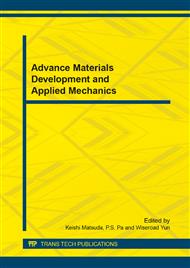[1]
J. Xu, B.H. Guo. Poly (butylene succinate) and its copolymers: research, development and industrialization, Biotechnology journal, 5 (2010), 1149-1163.
DOI: 10.1002/biot.201000136
Google Scholar
[2]
V. Tserki, P. Matzinos, E. Pavlidou, et. al. Biodegradable aliphatic polyesters. Part I. Properties and biodegradation of poly (butylene succinate-co-butylene adipate), Polymer degradation and stability, 91 (2006), 367-376.
DOI: 10.1016/j.polymdegradstab.2005.04.035
Google Scholar
[3]
A. Vassiliou, K. Chrissafis, D. Bikiaris, In situ prepared PBSu/SiO2 nanocomposites. Study of thermal degradation mechanism, Thermochimica Acta, 495 (2009), 120-128.
DOI: 10.1016/j.tca.2009.06.010
Google Scholar
[4]
S.S. Ray, Visualisation of Nanoclay Dispersion in Polymer Matrix by High‐Resolution Electron Microscopy Combined with Electron Tomography, Macromolecular Materials and Engineering, 294 (2009), 281-286.
DOI: 10.1002/mame.200900027
Google Scholar
[5]
P. Roy, S. Berger, P. Schmuki, TiO2 nanotubes: synthesis and applications, Angewandte Chemie International Edition, 50 (2011), 2904-2939.
DOI: 10.1002/anie.201001374
Google Scholar
[6]
Z. Qi, H. Ye, J. Xu, J. Chen, B. Guo, Improved the thermal and mechanical properties of poly (butylene succinate-co-butylene adipate) by forming nanocomposites with attapulgite, Colloids and Surfaces A: Physicochemical and Engineering Aspects, 421 (2013).
DOI: 10.1016/j.colsurfa.2012.12.051
Google Scholar
[7]
Z. Qi, H. Ye, J. Xu, J. Peng, J. Chen, B. Guo, Synthesis and characterizations of attapulgite reinforced branched poly (butylene succinate) nanocomposites, Colloids and Surfaces A: Physicochemical and Engineering Aspects, 436 (2013), 26-33.
DOI: 10.1016/j.colsurfa.2013.06.019
Google Scholar
[8]
T. Dong, Y. He, K. m. Shin, Y. Inoue, Formation and Characterization of Inclusion Complexes of Poly (butylene succinate) with α-and γ-Cyclodextrins, Macromolecular bioscience, 4 (2004), 1084-1091.
DOI: 10.1002/mabi.200400054
Google Scholar
[9]
Y.J. Phua, N.S. Lau, K. Sudesh, W.S. Chow, Z.M. Ishak, A study on the effects of organoclay content and compatibilizer addition on the properties of biodegradable poly (butylene succinate) nanocomposites under natural weathering, Journal of Composite Materials, (2014).
DOI: 10.1177/0021998314527328
Google Scholar


